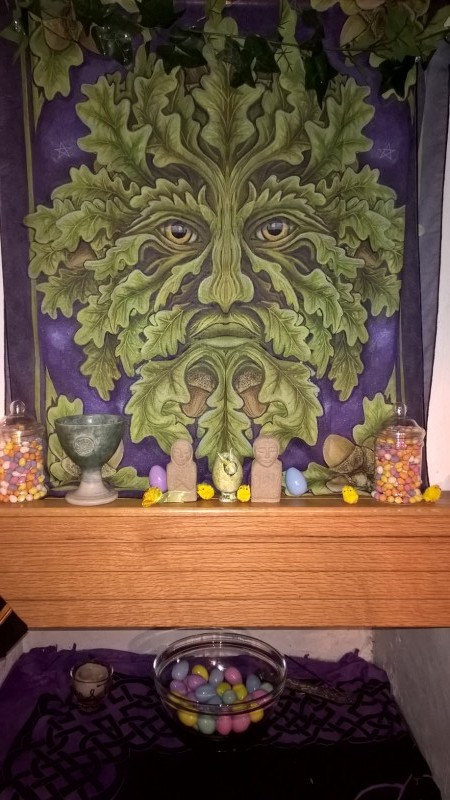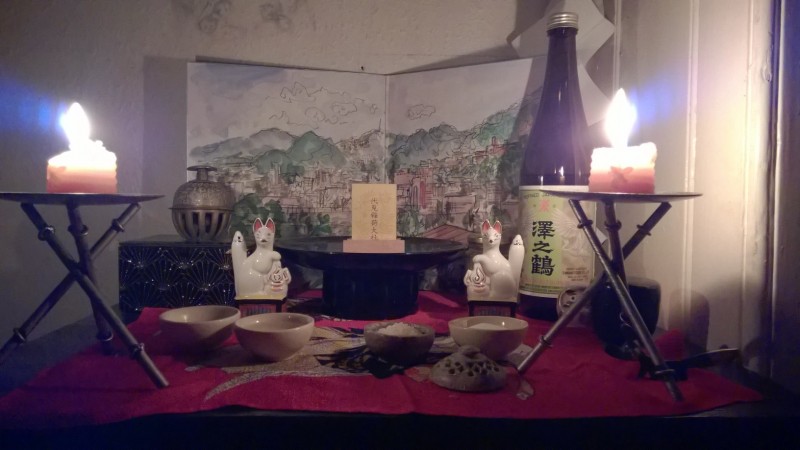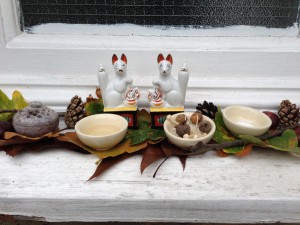
A Pagan Shrine for Ostara with easter eggs and stone figures of Mary & Joseph from a Saxon-inspired nativity set – a syncretic touch in a postmodern age
With the spread of Shinto overseas, there are some exciting transformations taking place as innovators adapt Japanese practice to their needs. This is particularly evident in the marriage of Shinto to contemporary paganism, with pioneers creating something that might be called Neo-Shintoism. (See an earlier piece on Minzoku NEO-shinto.)
One of the most articulate advocates of the neo-Shinto movement is Megan Manson, an eclectic pagan practising in the UK and piecing together a remarkably coherent set of practices. She runs her own blog, has lived in Japan and is involved with Japan-UK relations. In a recent article for the interfaith Patheos site, she wrote of “How I found the Shinto-Pagan Path“, and in the extract below she describes what initially drew her to Shinto.
**************
There are many possible reasons for the harmonious relationship between the scientific rationality and spiritual outlook held by a large proportion of the Japanese population, but I think one of the most important is that in Shinto, actions take precedence over belief. In my experience, many Japanese aren’t too sure what they believe at all – additionally, they do not consider having well-defined spiritual beliefs as particularly important. They’ll carry on making pilgrimages to shrines, going to festivals and taking part in seasonal Shinto rituals without worrying too much about whether or not the kami really exist. They do it partly because they enjoy doing it; it feels “right” to them.
When I realised this, I understood that this was the missing piece of the puzzle for me. I had approached Paganism from a Western, Christian perspective, probably due to my Catholic background. I thought that faith was a fundamental starting point for spirituality, and that one had to essentially choose between whether to trust in science or believe in religion. Shinto taught me that this was not the case at all. It taught me that it was OK to be a Pagan for no other reason than it feeling “right,” and that one could still follow a religion and hold scientific fact to be just as valid. As I grew to learn more about Neopaganism and the Pagan community, I realised that many other Pagans in fact feel exactly the same way.
I continued to use Shinto as a framework for my Pagan beliefs, and as I did so, I realised that I was becoming increasingly drawn to venerating the Shinto kami themselves along with Western Pagan deities, and one kami in particular: Inari Okami. Carrying across the Neopagan concept of a “patron” deity, I set up an altar to Inari in the courtyard outside our house, where we would often be visited by foxes. Inari has been my patron ever since.
Seeing the fox cross my path [one] summer afternoon gave me a moment of intense clarity. I understood that my interests in Paganism, science, and Japan were all connected. Whether or not this was truly a message from Inari, I suppose I’ll never know, but it was enough to confirm that I’d found the spiritual path for me – one that blended all of these ideas together.
So now I consider myself a Shinto-Pagan, practising both religions side by side. I celebrate the eight festivals of the Neopagan Wheel of the Year in addition to Japanese festivals. I participate in a local moot where our rituals are very much Wicca-influenced, invoking the Great God and Goddess and involving circle casting and calling the four elements; I also make regular offerings and Shinto norito prayers at my Inari altar.
To me, it seems natural to combine western Paganism with Shinto. Not only do the two religions have much in common in terms of their focus on ritual, nature worship and sense of duty to the ancestors, but as mentioned previously, Shinto is rarely practised in isolation from other religions in Japan. For me, Shinto is like a reactive chemical element – it likes to “bond” to other religious paths to create a new path that is best-suited to the practitioner. I find that my Shinto and Neopagan paths really complement and enhance one another. Even my blog’s title (Pagan Tama) reflects the Shinto-Pagan blend; the word “tama” is of special significance in Shinto and can be translated as “soul.”
Where my path will lead from now, I’m not sure. I feel that there is so much out there to learn and that I’ve only just begun. But as the Japanese say, senri no michi mo ippo yori hajimaru – “Even a journey of a thousand miles begins with a single step.”
********************
For a podcast with Megan, click here. Megan talks about her path to Shinto, some of the history of Shinto and how it relates to the other religions practiced in Japan. What is the difference between Japan and the West in regards to religious identity? What does it mean to be multi-faith, and how do we explain it to others?

Megan’s Shinto shrine is dedicated to Inari Okami. The picture behind is a painting done by an art teacher at the school in Nagasaki where she used to work – a view from the school window that now acts as a “window to Japan”.

